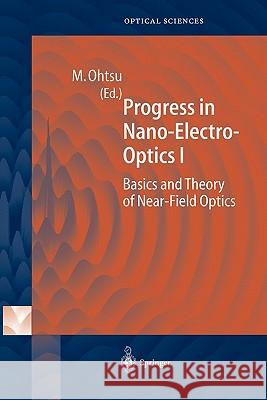Progress in Nano-Electro-Optics I: Basics and Theory of Near-Field Optics » książka



Progress in Nano-Electro-Optics I: Basics and Theory of Near-Field Optics
ISBN-13: 9783642078019 / Angielski / Miękka / 2010 / 164 str.
Progress in Nano-Electro-Optics I: Basics and Theory of Near-Field Optics
ISBN-13: 9783642078019 / Angielski / Miękka / 2010 / 164 str.
(netto: 383,36 VAT: 5%)
Najniższa cena z 30 dni: 385,52
ok. 22 dni roboczych.
Darmowa dostawa!
An up-to-date status report presenting the current state-of-the-art in nano-optics, this volume also deals with near-field optical microscopy. Each chapter is written by a leading scientist in the field. It will be useful to all researchers working at the forefront of near-field optics and nanoelectro-optics.
From the reviews:
"This unique monograph series entitled 'Progress in Nano-Electro-Optics' is being introduced to review the results of advanced studies in the field of electro-optics at nanometric scales and covers the most recent topics ... . this book is a very interesting one which can provide a very useful and multi-purpose tool for many users. ... Together these overviews will be a valuable resource for students, engineers and scientists. So let me recommend this book for everyone, readers or specialists ... ." (Yvon Renotte, Physicalia, Vol. 25 (4), 2003)
High-Throughput Probes for Near-Field Optics and Their Applications.- 1 High-Throughput Probes.- 1.1 Mode Analysis in a Metallized Tapered Probe.- 1.2 Light Propagation in a Tapered Probe with Ideal Metal Cladding.- 1.3 Measurement of the Spatial Distribution of Optical Near-Field Intensity in the Tapered Probe.- 1.4 Further Increase in Throughput.- 2 Application to High-Density and High-Speed Optical Memory.- 2.1 Using an Apertured Fiber Probe.- 2.2 High-Density and High-Speed Recording Using a Pyramidal Silicon Probe on a Contact Slider.- 3 Outlook.- References.- Modulation of an Electron Beam in Optical Near-Fields.- 1 Introduction.- 2 Review of Experiments.- 2.1 Smith—Purcell Effect.- 2.2 Schwarz—Hora Effect.- 3 Basic Principle.- 4 Microgap Interaction Circuits.- 4.1 Circuit Configuration.- 4.2 Transition Rates of Electrons.- 5 Theoretical Analyses of a Microslit.- 5.1 Near-Field Distributions.- 5.2 Wave Number Spectrum.- 5.3 Numerical Simulations.- 6 Experiment.- 6.1 Experimental Setup.- 6.2 Electron Energy Spectrum.- 6.3 Modulation with Laser Field.- 6.4 Wave Number Spectrum.- 7 Multiple-Gap Circuit.- 7.1 Inverse Smith—Purcell Effect.- 7.2 Experimental Setup.- 7.3 Phase Matching Condition.- 7.4 Field Distributions.- 8 Microslit for Visible Light.- 9 Conclusion.- References.- Fluorescence Spectroscopy with Surface Plasmon Excitation.- 1 Introduction.- 2 Theoretical Considerations.- 2.1 Surface Plasmons at the Interface Between a (Noble) Metal and a Dielectric Medium.- 2.2 Optical Excitation of Surface Plasmons.- 2.3 Surface Plasmons for the Characterization of Thin Layers.- 2.4 Electromagnetic Field Distribution near the Interface.- 2.5 Fluorescent Chromophores near Metal Surfaces.- 3 Experimental.- 4 Results and Discussion.- 4.1 Experimental Verifcation of Surface Field Enhancement.- 4.2 Frontside Versus Backside Emission.- 5 Conclusions.- References.- Optical Characterization of In(Ga)As/GaAs Self-assembled Quantum Dots Using Near-Field Spectroscopy.- 1 Introduction.- 2 Relaxation Mechanism.- 3 Optical Properties of Self-assembled Quantum Dots: Far-Field Analysis.- 3.1 Photoluminescence Spectroscopy.- 3.2 Magneto-Optical Spectroscopy.- 3.3 Photoluminescence Excitation Spectrosopy.- 3.4 Raman Spectroscopy.- 4 Near-Field Optical Spectroscopy.- 4.1 Ground-State Emission.- 4.2 Interaction with Phonons.- 4.3 Carrier Relaxation.- 4.4 Dephasing of Excited Carrier.- 4.5 Spin Relaxation.- 5 Conclusion.- References.- Quantum Theoretical Approach to Optical Near-Fields and Some Related Applications.- 1 Introduction.- 1.1 Basic Idea and Massive Virtual Photon Model.- 2 Projection Operator Method.- 2.1 Definition of the Projection Operator.- 2.2 Properties of the Projection Operator.- 3 Effective Operator and Effective Interaction.- 3.1 Equation for the Operator ? and Its Approximate Solution.- 3.2 Effective Interaction Operator in an Approximation.- 4 Electromagnetic Interaction with Matter: Minimal-Coupling and Multipole Hamiltonians.- 4.1 Minimal-Coupling Hamiltonian.- 4.2 Multipole Hamiltonian.- 5 Elementary Excitation Modes and Electronic Polarization.- 5.1 Polaritons and Electronic Polarization.- 6 Optical Near-Field Interaction: Yukawa Potential.- 6.1 Relevant Microscopic Subsystem and Irrelevant Macroscopic Subsystem.- 6.2 P Space and Q Space.- 6.3 Effective Interaction in the Nanometric Subsystem.- 6.4 Effective Mass Approximation of Exciton Polaritons and Yukawa Potential.- 7 Applications.- 7.1 Single Atom Manipulation.- 7.2 Fundamental Properties of Optical Near-Field Microscopy.- 8 Outlook.- References.
Motoiochi Ohtsu was appointed a Research Associate, an Associate professor, a Professor at the Tokyo Institute of Technology. From 1986 to 1987, while on leave from the Tokyo Institute of Technology, he joined the Crawford Hill Laboratory, AT&T Bell Laboratories, Holmdel, NJ. In 2004, he moved to the University of Tokyo as a professor. He has written over 417 papers and received 87 patents. He is the author, co-author, and editor of 55 books, including 22 in English. In 2000, he was appointed as the President of the Tokyo Chapter, LEOS, IEEE. From 2000, He is an executive director of the Japan Society of Applied Physics. His main field of interests is nanophotonics.He is a Fellow of the Optical Society of America, and a Fellow of the Japan Society of Applied Physics. He is also a Tandem Member of the Science Council of Japan. Awards: 14 prizes from academic institutions, including the Distinguished Achievement Award from the Institute of Electronics, Information and Communication Engineering of Japan in 2007, the Julius Springer Prize for Applied Physics in 2009.
This volume focuses on fundamental aspects of nano-electro-optics. Starting with fiber probes and related devices for generating and detecting the optical near-field with high efficiency and resolution, the next chapter addresses the modulation of an electron beam by optical near-fields. Further topics include: fluorescence spectroscopy, in which sample molecules are excited by the evanescent surface plasmon field close to metallic surfaces; spatially resolved near-field photoluminescence spectroscopy of semiconductor quantum dots, which will become an essential issue in future electro-optical devices and systems; and, finally, the quantum theory of the optical near-field. This latter theory accounts for all the essential features of the interaction between optical near-fields and nanomaterials, atoms and molecules. Together these overviews will be a valuable resource for engineers and scientists working in the field of nano-electro-optics.
1997-2026 DolnySlask.com Agencja Internetowa
KrainaKsiazek.PL - Księgarnia Internetowa









